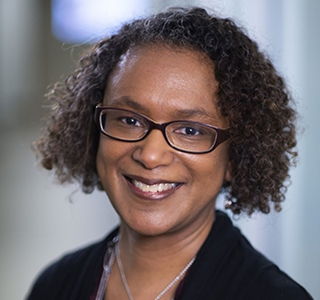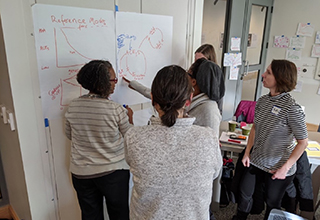August 23, 2022

Rather than avoid complicated — and sometimes controversial — environmental health issues, Devon Payne-Sturges, Dr.P.H., embraces the challenge of addressing them. She works at the intersection of pollution exposures, social stressors, and policy to understand how multiple factors interact to affect health.
Before joining the faculty at the University of Maryland, Payne-Sturges worked over 12 years at the U.S. Environmental Protection Agency (EPA). Her work with the NIEHS and EPA-funded Children’s Centers focused on science policy issues that impact children’s health disparities.
“Throughout my time at EPA, my work had a common theme around vulnerable populations, children’s health, and environmental health disparities,” she said. “I wanted those experiences and interests to stay with me when I transitioned to an academic career.”
In 2018, Payne-Sturges was awarded an NIEHS Career Development Grant to support her pursuit of a research career in environmental health sciences. Her project uses systems science — an interdisciplinary approach to thinking beyond the siloed environmental science field — to assess the effects of air pollution and psychosocial stressors on children’s neurodevelopment.
“Traditional approaches link an exposure to an outcome,” Payne-Sturges explained. “This grant has given me the time, space, and support to move away from a linear way of thinking and examine how multiple exposures interact with each other over time to contribute to cumulative risk and create health disparities.”
Understanding Cumulative Risks
The concept of cumulative environmental health risks refers to multiple exposures, including mixtures of contaminants and social or other factors, that have a greater impact combined than the sum of their separate parts.
“To tease out the cumulative risks, my colleagues and I first assessed the association of mothers’ exposure to air pollution during pregnancy with having low birthweight babies,” Payne-Sturges said. “Next, we wanted to determine if that relationship varied by indicators of social vulnerability, such as race and ethnicity.”
For every increase in exposure to air pollution, the team found a significant decrease in birthweight if either the mother or father identified as Asian American and Pacific Islander. The researchers suggested that birth outcomes could be further worsened by psychosocial stress stemming from poverty or racial discrimination.
Payne-Sturges and team are now following the babies of those women to see if exposure to air pollution during childhood impacts cognitive outcomes.
Through this work, Payne-Sturges seeks to eliminate disparities in health. She noted that while the environmental science field is good at describing disparities, it is not very effective at explaining why or how disparities occur.
Payne-Sturges makes the case for taking a systems approach in her 2021 publication on intervening to reduce children’s environmental neurodevelopmental risks. Systems modeling can provide insight about policy decisions and children’s health disparities so that scientific evidence can inform action.
“A systems approach can help us tell stories better,” she said. “When we understand how disparities are created, then we can understand what we need to do to fix them.”
Putting the Systems Approach into Practice

Payne-Sturges hosted a two-and-a-half-day workshop on using a systems approach to describe cumulative environmental stressors and children’s neurodevelopment.
Individuals from interdisciplinary backgrounds collaborated to create causal loop maps, which help to visualize how different variables in a system are interrelated.
“We wanted to illustrate how environmental exposures relate to the educational system, healthcare system, housing, and more,” she explained. “The activity opened participants’ minds to understand how their individual work has an influence on other sectors.”
Findings from the workshop were used to create a system dynamics simulation model. The model shows how exposure to environmental toxicants — lead, air pollution, and pesticides — can decrease children’s neurological function, which may be further intensified by social factors that increase stress, such as racial discrimination or poverty.
In addition to animating qualitative relationships among factors, the model can be used to calculate quantitative changes in exposures and health outcomes.
“If we reduce exposure to a chemical by a certain amount, and also address social vulnerabilities, such as issues in housing, we can calculate what the end result will be,” Payne-Sturges explained. “This opens up conversations with policymakers, researchers, and impacted communities to design policies that address multiple points in the systems map.”
Connecting Science to Policy
According to Payne-Sturges, current environmental policies regulate single pollutant exposures determined in the absence of any social context, likely underestimating true health risks.
She explained how discriminatory practices, such as disproportionate citing of pollution sources in communities of color, increase exposure to contaminants. This creates a reinforcing feedback in communities already at increased risk, leading to inequitable health outcomes among different racial and ethnic groups.
That's why Payne-Sturges is committed to advancing U.S. policy on cumulative environmental health impacts.
“We need more discussion about how policy decisions made in multiple sectors are connected,” she said. “Then we can break that cycle.”


